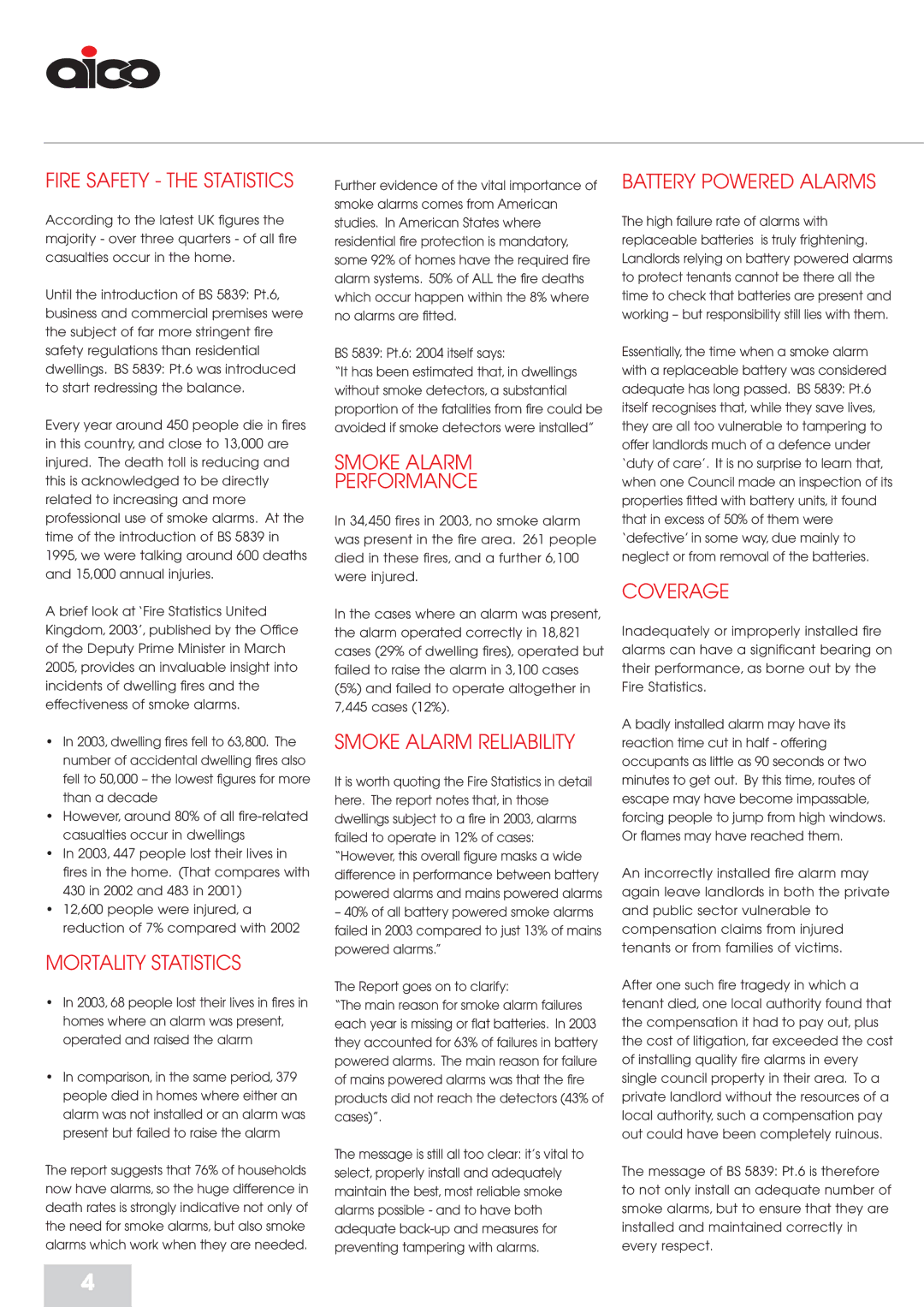FIRE SAFETY - THE STATISTICS
According to the latest UK figures the majority - over three quarters - of all fire casualties occur in the home.
Until the introduction of BS 5839: Pt.6, business and commercial premises were the subject of far more stringent fire safety regulations than residential dwellings. BS 5839: Pt.6 was introduced to start redressing the balance.
Every year around 450 people die in fires in this country, and close to 13,000 are injured. The death toll is reducing and this is acknowledged to be directly related to increasing and more professional use of smoke alarms. At the time of the introduction of BS 5839 in 1995, we were talking around 600 deaths and 15,000 annual injuries.
A brief look at ‘Fire Statistics United Kingdom, 2003’, published by the Office of the Deputy Prime Minister in March 2005, provides an invaluable insight into incidents of dwelling fires and the effectiveness of smoke alarms.
•In 2003, dwelling fires fell to 63,800. The number of accidental dwelling fires also fell to 50,000 – the lowest figures for more than a decade
•However, around 80% of all fire-related casualties occur in dwellings
•In 2003, 447 people lost their lives in fires in the home. (That compares with 430 in 2002 and 483 in 2001)
•12,600 people were injured, a reduction of 7% compared with 2002
MORTALITY STATISTICS
•In 2003, 68 people lost their lives in fires in homes where an alarm was present, operated and raised the alarm
•In comparison, in the same period, 379 people died in homes where either an alarm was not installed or an alarm was present but failed to raise the alarm
The report suggests that 76% of households now have alarms, so the huge difference in death rates is strongly indicative not only of the need for smoke alarms, but also smoke alarms which work when they are needed.
Further evidence of the vital importance of smoke alarms comes from American studies. In American States where residential fire protection is mandatory, some 92% of homes have the required fire alarm systems. 50% of ALL the fire deaths which occur happen within the 8% where no alarms are fitted.
BS 5839: Pt.6: 2004 itself says:
“It has been estimated that, in dwellings without smoke detectors, a substantial proportion of the fatalities from fire could be avoided if smoke detectors were installed”
SMOKE ALARM
PERFORMANCE
In 34,450 fires in 2003, no smoke alarm was present in the fire area. 261 people died in these fires, and a further 6,100 were injured.
In the cases where an alarm was present, the alarm operated correctly in 18,821 cases (29% of dwelling fires), operated but failed to raise the alarm in 3,100 cases (5%) and failed to operate altogether in 7,445 cases (12%).
SMOKE ALARM RELIABILITY
It is worth quoting the Fire Statistics in detail here. The report notes that, in those dwellings subject to a fire in 2003, alarms failed to operate in 12% of cases: “However, this overall figure masks a wide difference in performance between battery powered alarms and mains powered alarms
–40% of all battery powered smoke alarms failed in 2003 compared to just 13% of mains powered alarms.”
The Report goes on to clarify:
“The main reason for smoke alarm failures each year is missing or flat batteries. In 2003 they accounted for 63% of failures in battery powered alarms. The main reason for failure of mains powered alarms was that the fire products did not reach the detectors (43% of cases)”.
The message is still all too clear: it’s vital to select, properly install and adequately maintain the best, most reliable smoke alarms possible - and to have both adequate back-up and measures for preventing tampering with alarms.
BATTERY POWERED ALARMS
The high failure rate of alarms with replaceable batteries is truly frightening. Landlords relying on battery powered alarms to protect tenants cannot be there all the time to check that batteries are present and working – but responsibility still lies with them.
Essentially, the time when a smoke alarm with a replaceable battery was considered adequate has long passed. BS 5839: Pt.6 itself recognises that, while they save lives, they are all too vulnerable to tampering to offer landlords much of a defence under ‘duty of care’. It is no surprise to learn that, when one Council made an inspection of its properties fitted with battery units, it found that in excess of 50% of them were ‘defective’ in some way, due mainly to neglect or from removal of the batteries.
COVERAGE
Inadequately or improperly installed fire alarms can have a significant bearing on their performance, as borne out by the Fire Statistics.
A badly installed alarm may have its reaction time cut in half - offering occupants as little as 90 seconds or two minutes to get out. By this time, routes of escape may have become impassable, forcing people to jump from high windows. Or flames may have reached them.
An incorrectly installed fire alarm may again leave landlords in both the private and public sector vulnerable to compensation claims from injured tenants or from families of victims.
After one such fire tragedy in which a tenant died, one local authority found that the compensation it had to pay out, plus the cost of litigation, far exceeded the cost of installing quality fire alarms in every single council property in their area. To a private landlord without the resources of a local authority, such a compensation pay out could have been completely ruinous.
The message of BS 5839: Pt.6 is therefore to not only install an adequate number of smoke alarms, but to ensure that they are installed and maintained correctly in every respect.

